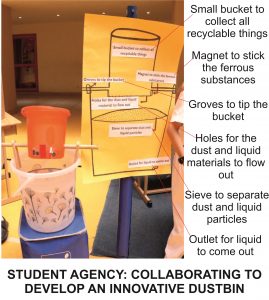Can collaboration in a transdisciplinary scenario support knowledge development outside the boundaries of a group of students? This article recounts the experience of students engaging in ‘cross collaboration’ outside their mentor- mentee groups to enable peers to reap the benefits of their inquiry during the PYP exhibition.
The primary years programme guides independent learners who have agency to develop knowledge that is backed by conceptual understanding. Given that students learn to synthesize and apply their learning, developing critical thinking skills within and outside the classrooms, I often found myself looking out for evidence of collaborative learning that added value to another student’s perspective. Could learning transcend the boundaries of working within specific groups alone?
The PYP exhibition afforded a unique opportunity to seek answers to ‘How the world works’. As students decided on the conceptual lens that appealed to them, they divided themselves into groups; the human saga (evolution), genetics, wheels of life (life cycles), natural disasters, properties of matter, machines, energy and artificial intelligence. I was wondering if students saw connections between key words. Could they share their understanding by ‘cross collaborating’ to provide useful information to their peers? My question began to be answered by a chart where students agreed amongst themselves to put in their topics in sequence demonstrating how each wielded an influence over the succeeding one and thereby enabling them to decide who to ask for extra information.
The subsequent weeks set the tone for inter-weaving understanding both within and across groups. During the course of their research, students were seen sharing information at lunch recess, washroom break and water refill times. To support this process, need based inter–group collaboration time was afforded by mentors. ‘Human saga’ (evolution) thus was related to Genetics and ‘Wheels of life’ (life cycles) of an organism. ‘Making of machines’ had an impact on ‘Artificial intelligence’. Questions arising within the ‘Natural disasters’ group shaped the need to analyse properties of matter so as to understand how to suggest improvements to the quality of human settlements. All these relationships were represented with colour codes from each group.
Knowledge is only restricted by one’s imagination. The collaboration was not water tight. It began to flow as ‘acts of evidence’ into work samples of various groups. The human evolution group gave credit to the life cycles group for their contribution in their e- book. Inquiries fueled action. For example, bicycles (machines) were used to promote fitness among visiting parents who rode them as a means of burning calories (energy). The ‘Properties of matter’ group together with the ‘Machines’ team pooled their understandings, and exemplified collaboration, through a student–teacher partnership creating of a unique dustbin.
As Suvaan said “I needed my friend Yaksham, for he knew about levers and axles while I was clear about what materials to use for filtration” while they were making their innovative dustbin that separated water, dust and liquids from larger organic waste.
All that is fundamental to the PYP exhibition was visible and more…. for collaborative processes demonstrated that students were not competing in groups but contributing towards the whole. Agency was evident as was knowledge development. Students made a choice and voiced their learning to create a welded whole. The partnerships were visible; students merely needed to be gently nudged on the path. The regret that stayed was my inability to get each student involved in cross collaboration. Use of a common platform where students could put out information relevant to others, affording more cross collaboration time for voicing ideas would have helped to tap into each student’s area of interest and understanding.
‘It’s possible’ is what students showcased through their own initiative and will; not just during planning but on the day of the exhibition too.
Kamal Shah is the PYP principal at DPS International, Gurugram, India. A primary years educator and ardent Montessorian, she is a firm believer in the use of manipulatives to nurture inquiry and creativity among young learners. Her advocacy for sustainable initiatives supports student action through mindful choices.





No comments yet.